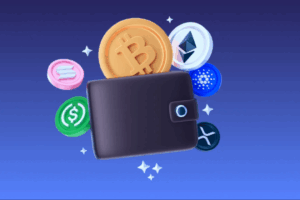How to Secure Your Crypto: Wallets & Best Practices Guide
In the dynamic world of cryptocurrency, taking charge of your digital assets isn’t just an option—it’s a necessity. Unlike traditional banks that safeguard your funds, the decentralized nature of crypto places the ultimate responsibility squarely on your shoulders. This guide will walk you through essential crypto security tips, from understanding different wallet types to implementing crucial best practices that safeguard your digital wealth.
Why Crypto Security is Non-Negotiable
The mantra in crypto is clear: “Not your keys, not your crypto.” This means if you don’t control the private keys that unlock your funds on the blockchain, you don’t truly own your crypto. The decentralized environment, while empowering, also means there’s no central authority to call if your funds are lost or stolen.
The threats are real and evolving. In the first half of 2025 alone, over $2.47 billion in cryptocurrency has been stolen through scams, hacks, and exploits, already exceeding the total amount lost in 2024. Phishing, wallet compromises, and sophisticated social engineering tactics (often powered by AI) are rampant. Understanding these risks is the first step toward effective self-custody.
Understanding Crypto Wallets: Your Digital Safe
A crypto wallet doesn’t “store” your cryptocurrency in the traditional sense. Instead, it holds your private keys, which are cryptographic codes that grant you access to your crypto on the blockchain. Think of it like this: your public key is your bank account number, while your private key is the PIN or password that lets you access and manage your funds.
Types of Crypto Wallets: Hot vs. Cold
Wallets are broadly categorized based on their connectivity to the internet, each with distinct security implications.
Hot Wallets (Online and Connected)
Definition: Software-based wallets that are always connected to the internet. They offer convenience but come with inherent security risks due to their online nature.
Pros:
- Convenience: Easy and quick access for frequent transactions, trading, or interacting with decentralized applications (dApps).
- User-Friendly: Often simpler for beginners to set up and navigate.
- Accessibility: Accessible from multiple devices (mobile, desktop).
Cons:
- Higher Vulnerability: More susceptible to online threats like hacks, malware, phishing attacks, and sophisticated social engineering scams (e.g., fake startup companies with AI-generated content used for malware distribution).
Sub-types & Examples:
- Exchange Wallets: Wallets provided by centralized cryptocurrency exchanges (e.g., Binance, Coinbase, Bybit).
- Warning: While convenient for trading, exchanges control your private keys. This means if the exchange is hacked (like the $1.4 billion Bybit breach in February 2025), your funds are at risk. Not recommended for long-term storage of significant amounts.
- Mobile Wallets: Apps installed on your smartphone (e.g., Trust Wallet, MetaMask Mobile, Zengo).
- Good for smaller amounts and daily use. Ensure your phone itself is secure.
- Desktop Wallets: Software installed on your computer (e.g., Exodus, Electrum).
- Your computer’s security is paramount. Malware can compromise desktop wallets.
- Browser Extension Wallets: Integrated into web browsers (e.g., MetaMask, Rabby Wallet).
- Popular for interacting with Web3, but browser vulnerabilities or malicious extensions pose risks.
Cold Wallets (Offline Storage)
Definition: Physical devices or methods that store your private keys completely offline, disconnected from the internet. This provides the highest level of security.
Pros:
- Superior Security: Immune to online hacks, malware, and phishing attacks. Ideal for safeguarding large holdings and long-term investments (HODLing).
- Full Control: You retain complete control over your private keys.
Cons:
- Less Convenient: Not ideal for frequent, small transactions. Requires physical access to the device.
- Cost: Hardware wallets require an upfront purchase.
Sub-types & Examples:
- Hardware Wallets: Dedicated physical devices designed specifically to store private keys offline. They sign transactions on the device itself before broadcasting them to the blockchain.
- Examples: Ledger Nano X/S Plus/Stax, Trezor Safe 3/Model T/Safe 5, Keystone 3 Pro, NGRAVE Zero, COLDCARD (Bitcoin-only), Tangem Wallet (card-based).
- Recommendation: These are considered the gold standard for crypto security. Many now offer intuitive touchscreens, robust security chips (EAL6+ certified), and broad coin support.
- Affiliate Opportunity: Link directly to official product pages for Ledger, Trezor, Keystone, etc.
- Paper Wallets: Private and public keys printed on a piece of paper.
- Warning: While offline, they are highly susceptible to physical damage (fire, water), loss, or simple deterioration. Generally discouraged for beginners due to the risks and complexity of secure generation.
Step-by-Step Crypto Security Best Practices
Implementing these practices is crucial for securing your digital assets, especially as threats like address poisoning (where tiny, zero-value transactions from addresses mimicking yours are sent, hoping you copy the malicious one for future transfers) and AI-driven deepfake scams become more prevalent.
1. Choose the Right Wallet for Your Needs
- For small amounts or active trading: A reputable hot wallet (mobile or browser extension) is acceptable, but ensure it’s from a trusted provider.
- For large amounts or long-term holding: A hardware wallet is absolutely essential. Don’t compromise on this.
2. Guard Your Seed Phrase (Recovery Phrase) Like Gold
This is the most critical piece of information you possess. It’s a sequence of 12 or 24 words that serves as the master key to your crypto, allowing you to recover your funds if your wallet is lost or damaged.
- Rule #1: NEVER store it digitally. This means no photos, screenshots, cloud storage, emails, text files, or password managers (unless it’s an offline password manager like KeePass, used with extreme caution).
- How to store it:
- Physical Copy: Write it down neatly on paper.
- Multiple Copies: Create at least two copies and store them in separate, secure, and undisclosed physical locations (e.g., a fireproof safe at home, a bank safe deposit box, a trusted friend’s secure location).
- Metal Seed Phrase Backup: For ultimate durability against fire, water, and time, consider engraving or stamping your seed phrase onto a metal plate. (Another affiliate opportunity – link to reputable metal backup products like Billfodl, Cryptosteel, or similar).
3. Enable Two-Factor Authentication (2FA) Everywhere
2FA adds an extra layer of security beyond just a password.
- Strongest 2FA: Use authenticator apps like Google Authenticator or Authy. These generate time-sensitive codes.
- Avoid: SMS-based 2FA, as it’s vulnerable to SIM swap attacks where scammers trick your mobile provider into transferring your number to their control.
- Apply to: All your crypto exchanges, email accounts linked to crypto, and any other crypto-related services you use.
4. Use Strong, Unique Passwords and a Password Manager
- Complexity is Key: Create long, complex, and random passwords for every single crypto-related account. Never reuse passwords.
- Password Manager: Use a reputable, encrypted password manager (e.g., 1Password, Bitwarden, LastPass) to generate and securely store your unique passwords.
5. Beware of Phishing, Scams, and Imposters 🎣
Scammers are increasingly sophisticated, using AI to craft hyper-realistic social engineering attacks.
- Phishing: Fake websites, emails, or messages designed to steal your credentials. Always double-check URLs for misspellings or extra characters before clicking or entering information. Verify email senders.
- Imposter Scams: Fake customer support, “giveaways,” or direct messages from seemingly legitimate entities (even verified accounts on social media can be compromised). Remember: Nobody legitimate will ever ask for your seed phrase or private keys.
- Download from Official Sources Only: Only download wallet software or apps from the official websites of the projects or from trusted app stores. Malware-laden fake apps are common.
- Address Poisoning: Be vigilant about this new scam trend. Always double-check the entire recipient address (especially the first few and last few characters) before sending funds, even if it looks similar to a previous transaction in your history.
6. Keep Software Updated
Regularly update your wallet applications, operating system (Windows, macOS, Android, iOS), and antivirus software. These updates often include critical security patches that protect against newly discovered vulnerabilities.
7. Use a Secure Internet Connection
- Avoid transacting or accessing your crypto accounts on unsecured public Wi-Fi networks.
- If you must use public Wi-Fi, always connect through a Virtual Private Network (VPN) to encrypt your internet traffic.
8. Verify Wallet Addresses Carefully
This cannot be stressed enough. Before you hit “send,” take a moment to triple-check the recipient’s wallet address. Copy-paste errors are common, and malicious software can even swap addresses on your clipboard. For large transfers, it’s wise to send a small “test” amount first to confirm it arrives correctly before sending the full amount.
9. Educate Yourself Continuously
The crypto security landscape is constantly evolving. Stay informed about the latest scams, vulnerabilities, and best practices. Follow reputable crypto security experts and news sources.
10. Consider a Dedicated Device for Crypto (Advanced)
For very substantial holdings, some experienced users opt for a dedicated computer or mobile device that is used only for crypto transactions and never for general Browse, email, or other activities that could expose it to malware.
Conclusion: Take Control of Your Crypto Future
Securing your crypto isn’t a one-time task; it’s an ongoing commitment. While the responsibility falls on you, the power to protect your digital wealth is entirely within your grasp. By understanding the fundamentals of crypto wallets and rigorously applying these security best practices, you can significantly mitigate risks and gain peace of mind in your crypto journey.
Don’t wait for a costly mistake to learn these lessons. Start securing your crypto today! Explore reputable hardware wallets and take the proactive steps necessary to protect your digital assets.













Post Comment